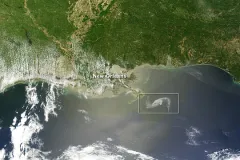State of Emergency in the Gulf

The explosion of Deepwater Horizon, an oil-drilling platform roughly 50 miles off the coast of Louisiana, is quickly growing into an environmental disaster that will leave its mark on coastal communities, fisheries, wildlife, and ecosystems along the Gulf Coast for decades to come. Officials estimate that the platform, which burned and then sank to a depth of 5,000 feet (over 1,500 meters) last week, is now leaking oil at a rate of at least 5,000 barrels (210,000 gallons) per day. The slick is 45 miles (72 kilometers) long and 100 miles (161 kilometers) wide—larger than the state of Rhode Island—and its magnitude could soon eclipse the infamous Exxon Valdez spill, which dumped 11 million gallons (42 million liters) of oil into the Prince William Sound in 1989. Disaster responders from NOAA, the Coast Guard, the Navy, the Air Force, and local agencies are working furiously to contain the spill using chemical dispersants, controlled burns, and physical barriers. Despite these efforts, officials are investigating reports that oil is beginning to wash ashore. Shrimp, oyster, and other fisheries are closing as the oil drifts toward the coast, and the fishing communities in Louisiana, where seafood is a $3 billion industry, are bracing for long-term impacts. The governors of Louisiana, Florida, and Alabama have all declared states of emergency. Wildlife and Gulf Coast ecosystems will feel heavy impacts from the oil itself and the chemicals used to contain it. Initially, birds and other species at the surface will be impacted most heavily, but as time goes on the oil will sink, affecting bottom-dwellers and species that live further down in the water column. Whales, dolphins, sea turtles, manatees, and other animals may be exposed by directly ingesting the chemicals or by eating prey that has been contaminated. The National Weather Service is predicting wind, thunderstorms, and high tides this weekend that could push oil deep into the inlets, ponds, and lakes that line the southeastern coast of Louisiana, further complicating clean-up efforts. For the latest updates on the spill and clean-up efforts, visit NOAA’s Office of Response and Restoration. If you're a teacher planning to discuss the oil spill with your class, browse classroom resources and activities from NOAA’s Office of Response and Restoration.

